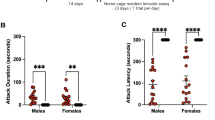Abstract
Offensive and defensive components of aggressive behavior were determined in resident and intruder mice. Withdrawal aggression was measured after the removal of a subcutaneous morphine pellet or after precipitation by naloxone in naive mice and after removal of a morphine pellet in mice with prior fighting experience. In naive mice, removal of a morphine pellet led to increases in attack bites and threats but naloxone-precipitated withdrawal led to decreases in these behaviors and to increases in defensive posturing, escape attempts and vocalizations. Prior fighting experience abolished the enhanced attack behaviors of resident mice following morphine pellet removal, but led to heightened defensive behavior in intruder mice. The behavior of intruder mice appeared more sensitive to naloxone administration than the behavior of resident mice; naloxone influenced not only intruder defensive behavior, but also other non-aggressive behaviors. The social role of the drug recipient and his prior history of aggressive behavior are important determinants of morphine and naloxone effects on aggression.
Similar content being viewed by others
References
Bernston GG, Walker JM (1977) Effect of opiate receptor blockade on pain sensitivity in the rat. Brain Res Bull 2:157–159
Blasig J, Herz A, Reinhold K, Zieglgansberger S (1973) Development of physical dependence and quantification of the precipitated withdrawal syndrome in rats. Psychopharmacologia 33:19–38
Blasig J, Hollt V, Herz A, Paschelke G (1976) Comparison of withdrawal precipitating properties of various morphine antagonists and partial agonists in relation to their stereospecific binding to brain homogenates. Psychopharmacologia 46:41–51
Cheney DL, Goldstein A (1971) Tolerance to opioid narcotics: time course and reversability of physical dependence in mice. Nature 232:477–478
Cochin J, Miller JM, Rosow CE, Grell R, Poulsen JL (1980) The influence of the mode of morphine administration on tolerance and dependence. In: Harris LS (ed) Problems of drug dependence 1979, NIDA Research Monograph 27. Superintendent of Documents, Washington, DC, pp 36–47
D'Amour FE, Smith DL (1941) A method for determining loss of pain sensation. J Pharmacol Exp Ther 72:74–79
Eichelman B (1979) Role of biogenic amines in aggressive behavior. In: Sandler M (ed) Psychopharmacology of aggression. Raven Press, New York, pp 61–91
Fanselow MS, Sigmundi KA, Bolles RC (1980) Naloxone pretreatment enhances shock-elicited aggression. Physiol Psychol 8:369–371
Gianutsos G, Hynes MD, Drawbaugh RB, Lal H (1975) Paradoxical absence of aggression during naloxone-precipitated morphine withdrawal. Psychopharmacologia 43:43–46
Gorelick DA, Elliott ML, Sbordone RJ (1981) Naloxone increases shock-elicited aggression in rats. Res Commun Substance Abuse 2:419–422
Jensen RA, Messing RB, Martinez JL, Vasquez BJ, McGaugh JL (1980) Opiate modulation of learning and memory in the rat. In: Poon LW (ed) Aging in the 1980's: Psychological issues. American Psychological Association, Washington, DC, pp 191–200
Lal H, O'Brien J, Puri SK (1971) Morphine-withdrawal aggression: sensitization by amphetamines. Psychopharmacologia 22:217–223
Lynch WC, Libby L, Johnson HF (1983) Naloxone inhibits intermale aggression in isolated mice. Pharmacology 79:370–371
Martin WR, Wikler A, Eades CG, Pescor FT (1963) Tolerance to and physical dependence on morphine in rats. Psychopharmacologia 4:247–260
Miczek KA (1982) Ethological analyses of drug action on aggression, defense and defeat. In: Spiegelstein MY, Levy A (eds) Behavioral models and the analysis of drug action. Elsevier Scientific, Amsterdam, pp 225–239
Miczek KA, O'Donnell JM (1978) Intruder-evoked aggression in isolated and non-isolated mice: effects of psychomotor stimulants and l-dopa. Psychopharmacology 57:47–55
Miczek KA, Krsiak M (1979) Drug effects on agonistic behavior. In: Thompson T, Dews PB (eds) Advances in behavioral pharmacology (vol 2). Academic Press, New York, pp 231–237
Miczek KA, Winslow JT (1985) Psychopharmacological research on aggressive behavior. In: Greensham AJ, Durish CT (eds) Experimental psychopharmacology. Humana Press, Clifton (in press)
Olivier B, van Dalen D (1982) Social behavior in rats and mice: an ethologically based model for differentiating psychoactive drugs. Aggress Behav 8:163–168
Puglisi-Allegra S, Mele A, Cabib S (1984) Involvement of endogenous opioid systems in social behavior of individually-housed mice. In: Miczek KA, Kruk MR, Oliver B (eds) Progress in clinical and biological research: ethopharmacological aggression research (vol 167). Alan R Liss, New York, pp 209–226
Redmond DE, Krystal JH (1984) Multiple mechanisms of withdrawal from opioid drugs. Ann Rev Neurosci 7:443–478
Robson LE, Kosterlitz HW (1979) Specific protection of the binding sites of d-ala2-d-leu5-enkephalin (delta-receptors) and dihydromorphine (mu-receptors). Proc R Soc Lond 205:425–432
Rodgers RJ, Hendrie CA (1983) Social conflict activates status-dependent endogenous analgesic or hyperalgesic mechanisms in male mice: effects of naloxone on nociception and behavior. Physiol Behav 30:775–780
Rodgers RJ, Hendrie CA (1984) On the role of endogenous opioid mechanisms in offense, defense and nociception. In: Miczek KA, Kruk MR, Oliver B (eds) Progress in clinical and biological research: ethopharmacological aggression research (vol 167). Alan R Liss, New York, pp 27–42
Sawynok J, Pinsky C, LaBella FS (1979) On the specificity of naloxone as an opiate antagonist. Life Sci 25:1621–1632
Simantov R, Snyder SH (1976) Elevated levels of enkephalin in morphine-dependent rats. Nature 262:505–507
Terenius L (1980) Opiate receptors: problems of definition and characterization. In: Pepov G, Kuhar MJ, Enna SJ (eds) Advances in biochemical psychopharmacology (vol 21): receptors for neurotransmitters and peptide hormones. Raven Press, New York, pp 321–337
Wei E, Loh HH, Way EL (1973) Quantitative aspects of precipitated abstinence in morphine-dependent rats. J Pharmacol Exp Ther 185:108–115
Yoburn BC, Huang T, Chen J, Cohen A, Inturrisi CE (1984) Pharmacokinetics and effects of morphine pellets in the rat. Neurosci Abstr 10:930
Author information
Authors and Affiliations
Rights and permissions
About this article
Cite this article
Kantak, K.M., Miczek, K.A. Aggression during morphine withdrawal: Effects of method of withdrawal, fighting experience, and social role. Psychopharmacology 90, 451–456 (1986). https://doi.org/10.1007/BF00174059
Received:
Revised:
Issue Date:
DOI: https://doi.org/10.1007/BF00174059




